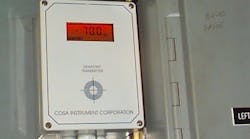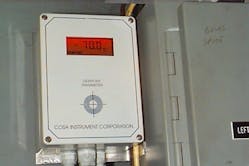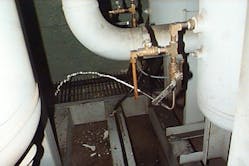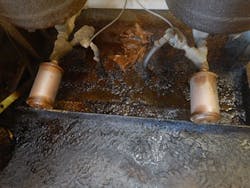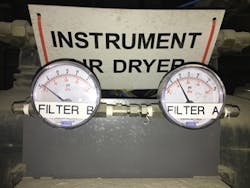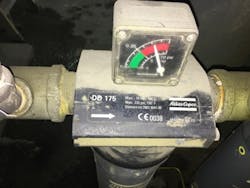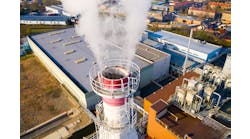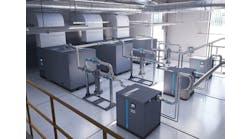Instrument air dryers are a necessary part of the compressed air system in a typical chemical plant. These devices and their associated filters remove water and lubricant from the compressed air that goes to sensitive instrumentation and control actuators. Such dryers act to pull down the dew point of the compressed air, even when ambient temperatures are low, so the air remains dry and contamination free. However, the units can experience problems. So, here, I’ll discuss some interesting issues I’ve encountered and ways to prevent them from occurring in your plant.
Compressed air occupies about one-eighth the original volume and can’t hold as much water vapor. The free water condenses out, leaving 100% saturated compressed air.
This saturated air is a problem. As it cools while passing through the main distribution piping, more water will condense out. That water will pick up pipe scale and rust and carry them downstream to the final end uses. Such contamination can ruin expensive instruments and cause malfunctions in control circuitry. In addition, if the pipes are exposed to freezing temperatures, ice will form — in some cases, building up in large enough quantities to restrict the flow of air.
Figure 1. The readout remained the same because the probe had failed.
To prevent these problems from happening, plants use instrument air dryers to reduce the dew point of the compressed air to well below the lowest temperature at the coolest location on the site. When we use the term “instrument air,” the typical requirement is to keep the pressure dew point at the discharge of the air dryer at least 18°F below the lowest temperature the pipes may encounter. Therefore, most plants with outdoor piping require air dryers that produce dew points well under freezing. This usually means using desiccant style dryers. However, if a plant doesn’t experience these conditions, it can gain significant cost savings by opting for refrigerated air dryers producing dew points between 35° and 40°F.
The Cost Of Air Drying
One of the issues with desiccant air drying is the cost of operation. About 15 to 20% of the flow rating of a fixed-cycle heatless desiccant air dryer (the most common type installed) is consumed by the dryer itself, through regeneration purge and the pressurization and depressurization of the dryer towers between cycles. Heatless desiccant dryers have twin towers filled with an adsorbent (usually activated alumina) to strip the water vapor from compressed air. One tower dries the air — usually for a 10-min cycle. Meanwhile, the other undergoes regeneration, which involves depressurizing it and passing some already dried compressed air through to drive off the adsorbed moisture.
However, compressed air isn’t free, consuming about 20 kW/100 cfm in a typical 100-psi system, which equates to about $2/hr/100 cfm at $0.10/kWh. Thus, operating a fixed-cycle heatless desiccant dryer sized at about 1,000 cfm costs around $31,000/yr. In contrast, the same size refrigerated dryer costs about $7,000/yr to run.
[callToAction]
Consider if this massive extra outlay really is necessary. Most dryers are rated for input conditions of full flow, 100°F and 100 psi — but actual conditions often differ widely from these levels. Such variance can have significant impact. For example, every 20°F reduction in input temperature cuts the amount of water vapor in the compressed air by about half. A dryer with an 80°F inlet temperature and handling 50% of rated flow would process only 25% of the amount of moisture at rated conditions. Yet, in an uncontrolled dryer using a fixed timer cycle to switch between towers, the unit still would consume the rated compressed air purge flow, wasting nearly 75% of it.
You can minimize wasted purge air by detecting the dew point at the discharge of the air dryer and turning off the purge when the dryer is producing air at lower dew points than rated (indicating the desiccant isn’t saturated yet). Opting for different desiccant dryer designs also can reduce dryer purge flow.
Figure 2. Despite an excellent dew point reading, water was pouring out of the after-filter.
Externally heated purge dryers use an electric heating element and a 4-hr cycle to better regenerate the desiccant while consuming only 7.5% of the dryer rating. In addition, some blower purge dryers use no compressed air for purge but instead pass ambient air through the heater element. Most require a flow of cooling air, about 2% of the dryer rating, to reduce desiccant temperature after the heating cycle. Some newer designs feature a closed-cycle cooling loop with radiant or water cooling to save cooling purge.
A heated dryer requires cooling because hot desiccant won’t adequately dry the air, causing a dew point spike. Heated dryers are deemed more efficient than heatless units; they indeed use less compressed air for purge but usually are more complex, more expensive and physically larger than the heatless type. And, of course, the heating element takes power. A typical 1,000-cfm heated blower dryer would incur about $17,000/yr in electricity costs at $0.10/kWh (including for cooling purge), $14,000 less than a heatless unit running uncontrolled at rated flow.
Desiccant air dryers often receive very little attention from maintenance staff unless they are causing trouble. So, let’s look at some common problems I’ve seen in real plants.
Trouble With Instruments
The cost numbers just cited underscore that controlling the dryer on dew point can reduce operating costs significantly if the dryer is experiencing lower-than-rated moisture loading (cooler temperatures and less flow). The typical dew point controller has some sort of humidity probe and an onboard display so operators can monitor the output of the dryer. This probe requires adjustment and calibration, points too often forgotten.
Figure 3. Appearance of oil and water at purge vents indicated contamination.
A paper plant can attest to problems caused by ignoring dew point instruments. At the site, regular hourly operator checks included recording the dew point readout. The operators dutifully wrote down the output reading as -70°C (Figure 1) over and over again for months. Yet an auditor checking the after-filter on the dryer found it full of water (Figure 2). The auditor confirmed the problem by removing the dew point probe from its measuring cell and waving it around in the steamy compressor room; the failure mode of the probe resulted in a continuous display of the same reading regardless of actual conditions.
A similar incident happened at a gypsum board plant with an externally heated dryer. The device was sized for two 150-hp compressors but only one compressor normally ran. This meant the dryer was greatly oversized for average flow. In addition, ambient conditions were cool and dry, reducing the moisture load to about 20% of rated conditions. However, data loggers monitoring the dryer cycles showed the unit was purging at almost full rated duty. The dew point readout appeared normal — until a second, recently calibrated meter was placed on the system and the readings compared. The onboard probe had become damaged and was reading 20°F higher than the actual level. The dryer was achieving -55°F dew points but the onboard meter read only -35°F. This failure prevented the dew point circuitry from turning off the purge, causing the device to consume five times more power and compressed air purge flow than necessary.
These failures point up the need to regularly calibrate dew point instruments as well as the value of a portable meter in detecting problems.
Mistakes In Settings
An incorrect setting for the air dryer is another common problem. Often, internal set points are altered or wrong for site conditions. For example, one major manufacturer of dryers recommends, when the dryer is new or the desiccant has been changed, turning off the dew point controller for a period of time to allow the desiccant beads to age slightly because new desiccant doesn’t yet have full capacity. This particular manufacturer hides the energy management system (EMS) on/off setting in a protected area of the controller, with the state of the controller not automatically displayed on the front panel. This means an operator can’t easily spot when the dew point controller is off.
A recent compressed air audit highlights the impact of an EMS inadvertently left off. A 400-cfm dryer was operating with an average loading of only 45 cfm but high peak flow near the dryer rating during parts of an 8-hr production day. The 80°F average compressor output temperature and the low flow meant the dryer was running at only 6% moisture loading. However, the dryer was purging at 60 cfm, as if the loading was at rated conditions — consuming 33% more than the entire average plant flow. A few button presses to activate the dew point control reduced the compressor power consumption by 57%. A check of an adjacent plant revealed a similar problem. Plant operators hadn’t realized they had to turn on the dew point controller with the function internal to the controller.
Ensuring the plant operators were trained on the operation of the dryer would have prevented the problem. Use of a continuous compressor efficiency monitoring system, which measures the input power of the compressor and compares it to the flow output to the plant (the difference being the dryer purge), would help in these situations.
Figure 4. High value resulting from a clogged dryer outlet filter led to doubled power consumption.
Component Failures
Desiccant dryers can suffer mechanical failures. Blower purge units, as the most complex variants, pose more potential challenges. When parts fail or problems happen with the reassembly of dryer parts, some extra unexpected power costs can develop.
Consider a problem at a food processor that purchased a salvaged desiccant dryer. The unit had to be taken apart for transport and reassembled on site. Immediately after commissioning, the plant started experiencing low pressure problems and called in a compressed air auditor. Monitoring of the system disclosed a telltale pressure signature of exactly 10-min duration, pointing to the dryer. Investigation revealed that on disassembly and shipping a purge orifice was lost. This orifice was designed to limit the purge flow to 15% of the rating of the dryer. Without the orifice, the dryer was consuming about 70% of the dryer flow rating.
A similar problem occurred at a sister plant, this time on a heated blower dryer. A compressed air audit uncovered a significant high flow event that coincided with the cooling cycle of the air dryer, every four hours on an uncontrolled dryer. Rather than consuming the rated 8% flow for about one hour (2% average), the cooling flow was measured at 20%. Investigation revealed that two solenoid valves were mixed up on assembly of the dryer; the wrong valve was activated during cooling purge.
Careful commissioning of the dryer could have prevented the problem. It’s important to measure both purge flow and cooling flow on startup to ensure adjustments are correct. Often, a purge flow setting will be adjustable; it can go out of adjustment or be incorrectly set in the first place.
Oversizing
Quite often, dryers will be oversized for various reasons; this can lead to problems with system efficiency. A fertilizer plant put in a 3,000-cfm heated blower purge dryer on a system because future plans called for installing three 900-cfm compressors. As time went on, plans changed — only one 900-cfm compressor actually was installed. Fortunately, this dryer had a working dew point controller, enabling some energy savings by preventing excessive purge. However, when its heating cycle ended, the additional flow, about 240 cfm, caused pressure problems. Loading conditions were such that this additional load required another compressor to run. However, none of the other compressors had automatic start. So, the operators ran a second compressor to ensure adequate capacity would be available about every 6-to-10 hours when the dryer cooling purge activated. This extra compressor operated mostly unloaded. The unloaded run time added over $21,000/yr in electrical costs.
When dryers are oversized, it’s important to ensure that the dew point controls are working. In some cases, right-sizing a dryer can be a more economical option.
Overheating And Contamination
Sometimes, a dryer that’s apparently correctly sized for the loading will fail to provide rated air quality. Often, the source of the problem is too much heat and contamination. As mentioned previously, every 20°F increase in temperature of the input air to the dryer roughly doubles the amount of water vapor entering the dryer. Because most dryers are rated for 100°F input, installing a dryer in conditions of excessive inlet temperature may cause overloading problems. Similarly, if significant amounts of compressor lubricant or free water enter the air dryer and contaminate the desiccant, the capacity of the dryer will decrease.
Figure 5. External differential pressure gauges often can enhance troubleshooting efforts.
A lime processing plant experienced issues with its air dryer not providing proper dew point. The pipes were outdoors where temperatures frequently reached -20°F, causing ice blockages. A compressed air audit showed problems with the compressed air system, which was located adjacent to a dusty loading area. The compressor cooling system often clogged up with dust, causing 120°F compressed air to enter the dryer. The dust ingested into the intake of the compressors jammed the compressor water separator drain, leading to free water passing downstream into the dryer filters. The system had no wet receiver tank. So, the water and a copious amount of compressor lubricant overwhelmed the dryer inlet filter, allowing water and oil to pass into the dryer. Figure 3 shows the result; water and lubricant being drained from the dryer purge vents is a sure sign of desiccant contamination. Contamination appearing at dryer vents should initiate immediate corrective action.
Pressure Drop
The inlet and outlet filters (and the filter drains) of an air dryer require regular maintenance. The filters prevent desiccant contamination. In addition, they impose a pressure drop that can affect the operation of the associated compressors. Excessive pressure differentials often reduce the efficiency of lubricated screw compressors; this can prompt a compressor running in load/unload control mode to cycle at a rapid frequency. The excess pressure also causes any running compressors to consume about 1% power for every 2-psi higher discharge pressure.
This condition existed at a food processor where a dryer was sized for one 100-hp compressor. Occasionally, a spare 100-hp compressor had to start to maintain plant pressure, greatly overloading the dryer and causing excessive internal velocities inside the dryer towers. This led the desiccant beads to wear against each other, creating dust that overloaded the dryer outlet filter. Excessive pressure differentials exceeding 25 psi developed across the dryer (Figure 4). Because the system receivers were downstream of the dryer, the compressor started rapidly cycling, consuming double the amount of power it required.
Take care to ensure dryers are properly sized for all possible conditions. Dryer filters need regular maintenance. Perform checks to verify excessive pressure drops aren’t developing. Often, accurate differential gauges placed across the dryer and filters can come in handy (Figure 5).
RON MARSHALL is principal of Marshall Compressed Air Consulting, Winnipeg, MB, and a Compressed Air Challenge instructor. E-mail him at [email protected].
